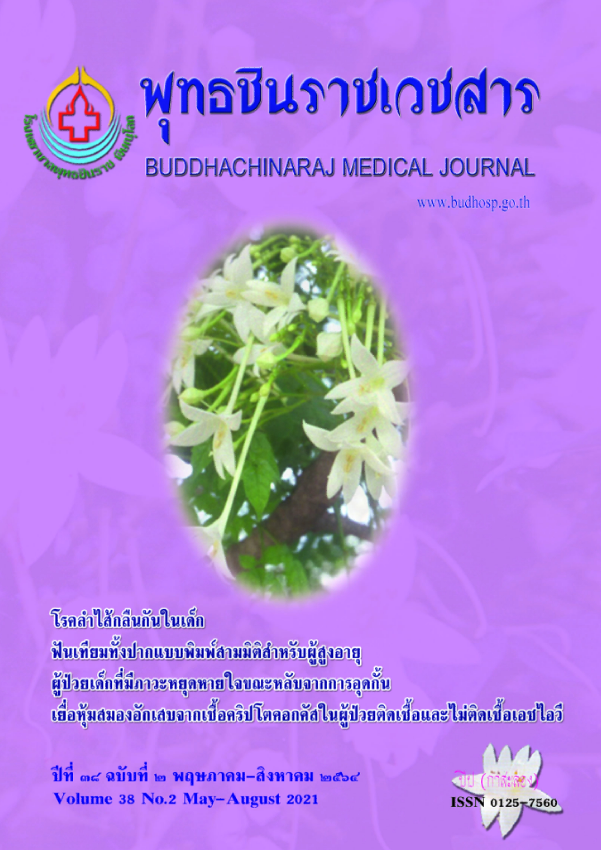ผลของการบริหารยานีโฟแพมระหว่างการผ่าตัดถุงน้ำดีผ่านกล้อง ในการระงับปวดหลังผ่าตัด
การบริหารยานีโฟแพมระหว่างการผ่าตัดถุงน้ำดีผ่านกล้อง
คำสำคัญ:
การผ่าตัดถุงน้ำดีผ่านกล้อง, การระงับปวดหลังผ่าตัด, นีโฟแพมบทคัดย่อ
การระงับปวดด้วยวิธีผสมผสานช่วยลดปริมาณและผลข้างเคียงของยาระงับปวด การให้นีโฟแพมช่วยลดคะแนนความเจ็บปวดและความต้องการยากลุ่มอนุพันธ์ฝิ่น การศึกษาแบบไปข้างหน้าแบบสุ่มและมีกลุ่มควบคุมครั้งนี้มีวัตถุประสงค์เพื่อเปรียบเทียบประสิทธิผลในการระงับปวดหลังผ่าตัดของการบริหารยานีโฟแพม 20 มิลลิกรัม ทางหลอดเลือดดำระหว่างการผ่าตัดถุงน้ำดีผ่านกล้องกับกลุ่มที่ไม่ได้รับยาและเปรียบเทียบปริมาณและผลข้างเคียง จากยากลุ่มอนุพันธ์ฝิ่นของผู้ป่วยทั้งสองกลุ่ม ซึ่งมีผู้ป่วยผ่าตัดถุงน้ำดีผ่านกล้อง 45 คนเข้าร่วมการวิจัย แต่ต้องคัดออกเหลือ 42 คน ผู้ ป่วยอายุเฉลี่ย 48 ปี (21-63 ปี) เป็นหญิง 31 ราย (ร้อยละ 73.8) ผู้ป่วยกลุ่มนีโฟแพมและกลุ่มยาหลอกได้รับมอร์ฟีนในห้องพักฟื้นเฉลี่ย 4.90 และ 4.86 มิลลิกรัมตามลำดับ (p = 0.952) และปริมาณมอร์ฟีนที่ได้รับใน 24 ชั่วโมงหลังผ่าตัดเฉลี่ย 6.14 และ 5.81 มิลลิกรัมตามลำดับ (p = 0.743) อาการ ไม่พึงประสงค์ในผู้ป่วยทั้งสองกลุ่มไม่แตกต่างกัน โดยแต่ละกลุ่มพบอาการคลื่นไส้อาเจียนร้อยละ 42.9 และมีอาการปัสสาวะไม่ออกกลุ่มละ 1 คน สรุปได้ว่าการบริหารนีโฟแพมทางหลอดเลือดดำระหว่างการผ่าตัดถุงน้ำดีผ่านกล้องไม่มีผลเปลี่ยนแปลงปริมาณมอร์ฟีนที่ผู้ป่วยได้รับในห้องพักฟื้น และในช่วง 24 ชั่วโมงแรกหลังผ่าตัด โดยอาการไม่พึงประสงค์ทั้งสองกลุ่มไม่แตกต่างกัน
เอกสารอ้างอิง
2. Tebala GD, Belvedere A, Keane S, Khan AQ, Osman A. Day-case laparoscopic cholecystectomy: analysis of the factors allowing early discharge. Updates Surg 2017;69(4):461-9.
3. Rosero EB, Joshi GP. Hospital readmission after ambulatory laparoscopic cholecystectomy: incidence and predictors. J Surg Res 2017;219:108-15. doi: 10.1016/j.jss.2017.05.071
4. Gould TH, Crosby DL, Harmer M, Lloyd SM, Lunn JN, Rees GA, et al. Policy for controlling pain after surgery: effect of sequential changes in management. BMJ 1992;305(6863):1187-93. doi: 10.1136/bmj.305.6863.1187
5. Hilvering B, Draaisma WA, van der Bilt JDW, Valk RM, Kofman KE, Consten ECJ. Randomized clinical trial of combined preincisional infiltration and intraperitoneal instillation of levobupivacaine for postoperative pain after laparoscopic cholecystectomy. Br J Surg 2011;98(6):784-9.
6. Kehlet H, Jensen TS, Woolf CJ. Persistent postsurgical pain: risk factors and prevention. Lancet (London, England) 2006;367(9522):1618-25.
7. Patel HRH, Linares A, Joseph JV. Robotic and laparoscopic surgery: cost and training. Surg Oncol 2009;18(3):242-6.
8. Kehlet H, Holte K. Effect of postoperative analgesia on surgical outcome. Br J Anaesth 2001;87(1):62-72.
9. Sanansilp V. Postoperative pain management. In: Phakanrattana U, Sanansilp V, Suksompong S, Toomtong P, editors. Textbook of anesthesia. Bangkok, Thailand: Department of Anesthesiology, Faculty of Medicine, Siriraj Hospital, Mahidol University; 2013. p.781-808.
10. The Royal College of Anesthesiologists of Thailand, Thai Association for the Study of Pain. Clinical Guidance for Acute Postoperative Pain Management. Bangkok, Thailand: The Royal College of Anesthesiologists of Thailand; 2019.
11. Alfonsi P, Adam F, Passard A, Guignard B, Sessler DI, Chauvin M. Nefopam, a non-sedative benzoxazocine analgesic, selectively reduces the shivering threshold. Anesthesiology 2004;100(1):37-43.
12. Choi SK, Yoon MH, Choi J Il, Kim WM, Heo BH, Park KS, et al. Comparison of effects of intraoperative nefopam and ketamine infusion on managing postoperative pain after laparoscopic cholecystectomy administered remifentanil. Korean J Anesthesiol 2016;69(5):480-6.
13. Zhao T, Shen Z, Sheng S. The efficacy and safety of nefopam for pain relief during laparoscopic cholecystectomy: a metaanalysis. Medicine 2018;97(10):e0089. doi:10.1097/MD.0000000000010089
14. Kim EM, Jeon JH, Chung MH, Choi EM, Baek SH, Jeon PH, et al. The effect of nefopam infusion during laparascopic cholecystectomy on postoperative pain. Intern J Med Sci 2017;14(6):570-7.
15. McLintock TT, Kenny GN, Howie JC, McArdle CS, Lawrie S, Aitken H. Assessment of the analgesic efficacy of nefopam hydrochloride after upper abdominal surgery: a study using patient controlled analgesia.Br J Surg 1988;75(8):779-81.
16. Mimoz O, Incagnoli P, Josse C, Gillon MC, Kuhlman L, Mirand A, et al. Analgesic efficacy and safety of nefopam vs. propacetamol following hepatic resection. Anaesthesia 2001;56(6):520-5.
17. Hudcova J, McNicol E, Quah C, Lau J, Carr DB. Patient controlled opioid analgesia versus conventional opioid analgesia for postoperative pain. Cochrane Database Sys Rev 2006;18(4):Cd003348. doi: 10.1002/14651858.CD003348.pub2
18. Chompubai P, Chaiboon P, Taecholarn P. Analgesia after administration of one or two dose of nefopam for appendectomy: a randomized controlled trial. Thai J Anesthesiol 2019;45(1):27-33.






